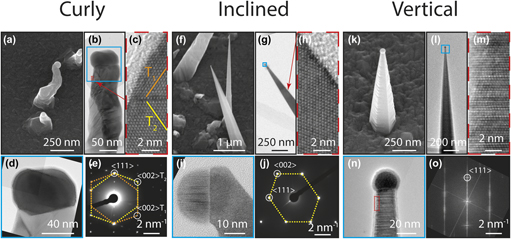Crossref Citations
This article has been cited by the following publications. This list is generated based on data provided by
Crossref.
Lindberg, Caroline
Whiticar, Alexander
Dick, Kimberly A.
Sköld, Niklas
Nygård, Jesper
and
Bolinsson, Jessica
2016.
Silver as Seed-Particle Material for GaAs Nanowires—Dictating Crystal Phase and Growth Direction by Substrate Orientation.
Nano Letters,
Vol. 16,
Issue. 4,
p.
2181.
Campos, Tiago
Faria Junior, Paulo E.
Gmitra, Martin
Sipahi, Guilherme M.
and
Fabian, Jaroslav
2018.
Spin-orbit coupling effects in zinc-blende InSb and wurtzite InAs nanowires: Realistic calculations with multiband
k·p
method.
Physical Review B,
Vol. 97,
Issue. 24,
Sun, Jiamin
Yin, Yanxue
Han, Mingming
Yang, Zai-xing
Lan, Changyong
Liu, Lizhe
Wang, Ying
Han, Ning
Shen, Lifan
Wu, Xinglong
and
Ho, Johnny C.
2018.
Nonpolar-Oriented Wurtzite InP Nanowires with Electron Mobility Approaching the Theoretical Limit.
ACS Nano,
Vol. 12,
Issue. 10,
p.
10410.
Joyce, H.J.
2019.
Metalorganic Vapor Phase Epitaxy (MOVPE).
p.
217.
Sarkar, Krishnendu
and
Banerji, Pallab
2019.
Diameter‐Dependent Growth Direction of InxGa1−xAs Nanowires: Transition from Nanowire Growth to Substrate Etching with Silver Catalyst Size.
physica status solidi (b),
Vol. 256,
Issue. 10,
Hallberg, Robert T
Messing, Maria E
and
Dick, Kimberly A
2019.
Nanowire morphology and particle phase control by tuning the In concentration of the foreign metal nanoparticle.
Nanotechnology,
Vol. 30,
Issue. 5,
p.
054005.
McIntyre, P.C.
and
Fontcuberta i Morral, A.
2020.
Semiconductor nanowires: to grow or not to grow?.
Materials Today Nano,
Vol. 9,
Issue. ,
p.
100058.
Maliakkal, Carina B
Jacobsson, Daniel
Tornberg, Marcus
and
Dick, Kimberly A
2022.
Post-nucleation evolution of the liquid–solid interface in nanowire growth.
Nanotechnology,
Vol. 33,
Issue. 10,
p.
105607.
Bermeo, Marie
Franzen, Sara M
Hetherington, Crispin
Johansson, Jonas
and
Messing, Maria E
2023.
Branched-gallium phosphide nanowires seeded by palladium nanoparticles.
Nanotechnology,
Vol. 34,
Issue. 39,
p.
395603.
Hu, Tianyi
Seifner, Michael S.
Snellman, Markus
Jacobsson, Daniel
Sedrpooshan, Mehran
Ternero, Pau
Messing, Maria E.
and
Dick, Kimberly A.
2023.
Direct Observation of Liquid–Solid Two‐Phase Seed Particle‐Assisted Kinking in GaP Nanowire Growth.
Small Structures,
Vol. 4,
Issue. 9,
Hu, Tianyi
Cao, Yuanyuan
Franzén, Sara M.
Jacobsson, Daniel
Seifner, Michael S.
Messing, Maria E.
and
Dick, Kimberly A.
2025.
In Situ Manipulation of Growth Mechanisms in the Vapor–Solid–Solid Growth of GaP Nanowires.
Advanced Materials Interfaces,
Vol. 12,
Issue. 11,
